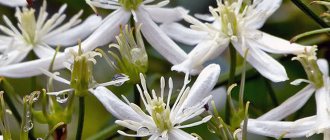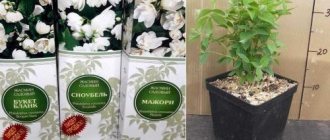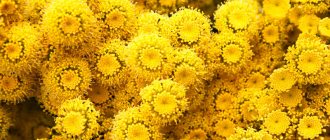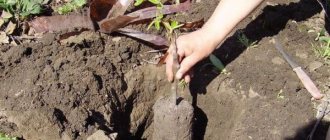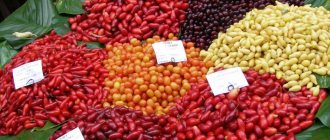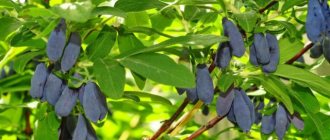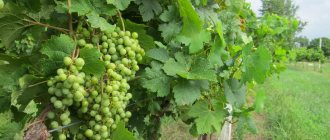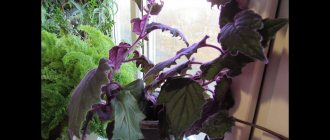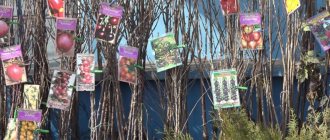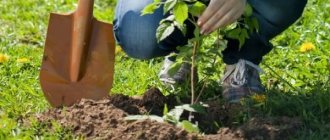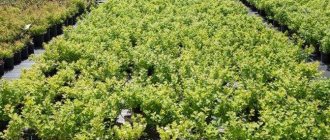At the end of May, after the rhododendrons, most varieties of lilac and weigel have faded, the leaves of the derena, or svidina, a unique shrub that remains highly decorative throughout the year, finally fully bloom in the garden. Gardeners who know the characteristics of shrubs can easily create a garden only from various types and varieties of wood, characterized by an amazing variety of shapes, sizes and colors of shoots and leaves. In the middle zone, three types of derain are completely frost-resistant: white, blood-red and scion. And there are several dozen varieties of wood.
Derain is a real shrub – a “chameleon”. Its bright red and yellow-green branches in winter and early spring combine well with evergreen conifers and perennial grasses against a background of snow. Later, no less attractive rich green ovoid leaves with a pointed tip bloom on the branches of the derain, like those of the white “Sibirika” or blood-red “New Red” derain. The elegant variety “Aurea” has soft yellow leaves. The edged and variegated varieties are especially decorative: white-green “Elegantissima” and “Sibirika Variegata”, yellow “Ayrea Elegantissima” and “Spaeti”, creamy-white “Variegata”. With the onset of cold weather, the turf changes again; the characteristic colors of autumn are deep yellow, orange and purple.
Is it necessary to cut the turf? The answer to this question depends on the style of your garden and the place of the shrubs in it. In large landscape gardens, you can leave the turf in its natural form, regularly carrying out formative and rejuvenating pruning of the bushes. In this case, in the spring, a third of the oldest branches are cut out, and last year’s unsightly or too long shoots are removed.
On the other hand, derain tolerates regular pruning painlessly, and this allows you to experiment with the geometry of the bush in a fashionable modern trend in garden design - dendroplasty, or the art of creating relief and volumes from plants. Erroneously shortened tree shoots will quickly grow back and the overall decorative value of the shrub will remain high. It is better to start shaping the bush a year to a year and a half after planting.
To create geometric trimmed figures, balls, cubes or hemispheres , old (over 3 years old) and bare branches are cut out of wood in early spring at a height of about 10-15 cm from the ground. Younger shoots and growth from the current year will serve as the basis for creating the required volume at ground level. The shape of the bush is corrected by pruning the tips of the shoots in the spring and twice in July-August, as soon as the young shoots reach a height of two to three leaves above the level of the old branches.
Turf grown on a low trunk will look original in the garden. To do this, select one or several young powerful shoots, which are tied or intertwined with each other or tied to a vertical support. These shoots, which will become the future stem, are shortened at a height of about 0.5 m. The remaining branches are cut at the root. The crown is formed from the apical branches, regularly removing shoots on the ground and new branches on the trunk.
Particularly interesting are the variegated tree trees, which produce figures that are not just green or yellow, but also bluish-white and golden-white. In some varieties, in sunny areas, green is combined with cream and pink and even red spots, for example, like the “Gouchault” variety.
For the formation of hemispheres with a diameter of up to 0.5 m, the dwarf variety of sprouting tree “Kelsey” is perfect, for forms up to 1.5 m - the tree “Ivory Halo” with white-edged foliage. Fast-growing varieties will require more frequent formative pruning.
An unpretentious turf will become a decoration of any garden a few years after planting and will give it uniqueness at any time of the year.
Popular publications
latest comments
HOW TO FORM A TREE
It is difficult to find an ornamental plant that is more flexible and profitable to grow than white dogwood. This plant has a huge number of different shapes, varieties and colors, including variegated ones, with a rich range of colors.
Svidina is an excellent plant for beginning gardeners.
It is extremely unpretentious, tolerant of not very fertile soils, tolerates drought, lack of care and partial shade. Derain grows very quickly and recovers well after pruning, returning the bright, juicy color of the young bark.
In order for the fast-growing plant to maintain a beautiful compact shape, it must be constantly looked after, pinched and pruned regularly. The plant tolerates these procedures perfectly, thanks to its owners with its beautiful decorative forms and lush foliage.
To learn how to form a turf according to all the rules, you should understand how this plant relates to pruning. Caring for a plant depends on its type. Trees with bright bark are most decorative in the winter season. To preserve such a beautiful color of the shoots, the plant has to be completely cut out every two years. Therefore, this type of tree is best formed in the form of a bush or hedge. Elegant variegated forms are attractive precisely because of their foliage, so it is best to form them in a column or in a standard form, in the form of a small tree.
How to do something yourself, with your own hands - home craftsman website
AN EXCELLENT TOOL FOR CRAFTS AND HANDCRAFTS AND EVERYTHING FOR THE GARDEN, HOME AND Cottage LITERALLY FOR FREE - SEE FOR YOURSELF. THERE ARE REVIEWS.
Ornamental shrubs greatly decorate the garden plot.
Thanks to them, the garden landscape becomes more expressive, voluminous and colorful. Some shrubs achieve their maximum decorative effect during flowering, others - during the ripening of fruits, others are distinguished by a rich palette of leaves that change color depending on the season, others - by elegant bark that stands out piercingly in the cold season... But each of them can be attractive in any time of the year, if it has a beautiful shape. And this is achieved by regular pruning.
Winter-hardy plants can be pruned at any time of the year. Those that are not winter-hardy are best pruned in the spring (the exception is roses, which we prune to cover them: they overwinter better under cover).
Creating elegant garden forms from wood
White tree pruning begins at the age of three. Weak and old branches are cut out, as well as those branches that have grown strongly beyond the crown of the bush and disrupted its shape. In this way, those bushes that grow in single groups are pruned. If you do not prune the tree every year, the bushes will lose their decorative appearance, as their lower part becomes exposed.
Bush species that have brightly colored bark are pruned once every two years, leaving stumps 5 cm from the ground, to stimulate the formation of new, more brightly colored shoots.
An already formed derain hedge is cut 2 times in July - August, after the growth of young shoots has stopped.
Pruning spirea (pictured)
One of the most popular shrubs is spirea . They have a lot of advantages: they bloom beautifully, are unpretentious, frost-resistant, and have many types and garden forms.
TOOLS FOR HOME AND GARDEN, HANDCRAFTS, ETC. PRICES VERY LOW
Spiraea are divided into two large groups: spring- and summer-flowering.
The first ones bloom on last year's shoots, and their flowers are mostly white, collected in umbrella-shaped inflorescences. Prune the bushes immediately after flowering, completely removing shoots older than 5 years.
If you trim spring-flowering spirea (Vangutta, gray, Nippon, etc.) in the spring, after flowering, it will produce a large number of shoots, which will also delight you with abundant flowering next year.
If you cut it in the second half of summer, you won’t get flowering the next year. Or you will get it so weak that there will be no point in keeping it for flowering, just for the sake of shape. And these spirea are formed perfectly: if you want - in a ball, if you want - in a cube.
Or you can use them to create a beautiful border or hedge. Summer-flowering spirea (Bumalda, Japanese - 'Little Princess', 'Golden Princess', 'Shirobana', etc.) bloom on the shoots of the current growth. They can be cut as you like and whenever you want, they will still grow and bloom, albeit later, but will give you the decorative effect that you want. The more often you prune summer spirea, the more compact, dense and fluffy they become, but the less flowering they will have. Therefore, it is better to trim the bushes after flowering or in early spring, cutting them very short - 15-30 cm above the soil surface.
From the buds remaining on the stems, strong young shoots grow, on the tops of which, by mid-summer, bright flowers (most often pink or red), collected in large corymbose or paniculate inflorescences, bloom.
Landing
Planting variegated dogwood does not pose any particular difficulties: it is undemanding and grows well on different types of soil. The main thing is that it is not waterlogged; in such cases it is necessary to provide additional drainage.
Selecting a location
Fertile soil is considered ideal, but sandy or clay soil is also suitable. The main condition is the occurrence of groundwater at a depth of at least 1.5 m. Otherwise, increased humidity will lead to diseases of the root system.
Requirements for sunlight are not strict. The bushes grow well both in direct sunlight and in partial shade.
Please note: there are several varieties for which insufficient light is undesirable. Growth deteriorates, and the color becomes monochromatic. This is especially true for species with bright colors.
The landing site is determined by expediency. If you plan to create a hedge, then you need to plant it “in a cluster.” In such cases, varieties with erect stems are suitable. For compositional design, it is better to choose low-growing species with spreading branches. They perfectly decorate trees whose crown is located at a height (the main thing is that the crown does not greatly shade the bushes growing below). In this case, space for growth and formative pruning will be required. For a single landing you need space. To make an overgrown shrub look impressive, leave an area for it with a diameter of up to 3 meters.
Select a planting site in advance, taking into account the characteristics of the selected variety. Adult specimens do not tolerate transplantation well. It is done only in the most extreme cases, preserving the earthen lump, only in early spring or late autumn. Carefully transferred shrubs need to be watered and mulched with peat chips. The main reasons for replanting are the threat to other plants due to the overgrown root system. Or gradual loss of main varietal characteristics and wilting.
Boarding time
The best time for planting is spring. By the time the soil and air warm up, you need to prepare the soil. Seedlings are more sensitive to temperature conditions; they require time to adapt and more attentive care. The optimal air temperature is +12 – 150, for soil – from 10 and above, and at a depth of at least 12 centimeters.
Please note: planting in autumn is not recommended. It takes time for the seedlings to take root and overwinter well.
How to plant
Once a location has been selected, you must:
- prepare a planting hole 65 cm deep and 50 cm in diameter (or a ditch if you plan to make a fence);
- waterlogged soil should be drained;
- Organic fertilizers are added to the pit (humus or compost, up to 10 kg in each pit);
- Before planting, it is better to moisten the dried roots: to do this, place it in a bucket of water so that the roots are saturated with moisture.
Actually, this is where the preparation ends. The seedlings are fixed in the ground; for this, soil is added, and the seedling itself is shaken a little to fill the voids. The distance should be at least 1.5 - 2 meters, with the exception of creating a hedge, then it is reduced by three to four times.
The root collar should be above the surface at a level of 2-3 cm. If it is deeply buried, the seedling will die; if it is buried less, the shoots will be weak.
After planting, each hole should be watered (with warm water, about 20 liters will be required), and the soil should be carefully loosened and mulched after planting.
To quickly strengthen the root system, you can treat it with a slurry of fresh cow manure and powdered clay diluted with water. When planting alone, you can install a peg for support (the length should be 20 cm longer than the seedling). It is stuck into the bottom of the hole at a short distance.
How to choose a seedling
For rooting and good growth, you need to choose seedlings no older than 4 years. The taproot must be at least 20 cm, without rotten shoots. The root system of healthy specimens is flexible and elastic, the bark of the stems is smooth and uniform.
Young animals should be fed with mineral fertilizers. It is better to alternate root feeding with foliar feeding. It is better to make the first wintering in a particularly harsh climate soft: it should be covered with breathable materials. But you shouldn’t insulate it too much; too much heat will cause it to dry out.
Derain pruning
Derain (the most popular are white Shpeta and Elegantissima) can be cut well at any time. You can cut it to any height and give it any shape. The main thing is to know what you want from him. If you admire the clear graphics of brightly colored shoots in the winter garden, cut it short in early spring.
Over the summer, the turf will grow annual shoots up to 0.5-1 m long, which will turn deep red with the onset of cold weather. If you want to have a lush bush with a beautiful shape, decorated with variegated leaves, inflorescences of cream flowers, and then white berries, then shorten the branches to the height you need.
Brief description of cultivation
- Bloom . The shrub blooms luxuriantly from early to mid-summer. It blooms again in the first weeks of autumn.
- Landing . In autumn during leaf fall or in spring - before sap flow begins.
- Watering . While the plant is young, it is watered once or twice every 7 days. Adult bushes are watered only during prolonged drought, twice or thrice a month, and from 15 to 20 liters of water are taken per plant.
- Fertilizer . If the soil is nutritious, then the turf will be able to grow normally without fertilizing. In depleted soil in the spring, 100 to 150 grams of mineral complex fertilizer should be added to the soil under the bush. And in the summer months, 5 to 7 kilograms of humus are added under the bush.
- Trimming . After the white dogwood turns 3 years old, it begins to be trimmed regularly. They do this 2 times a year, or more precisely: in July and August. Species and varieties that have richly colored bark should be pruned at the very beginning of spring, but only once every few years.
- Reproduction . Layering, seed method and cuttings.
- Pests . Aphids and scale insects are comma-shaped.
- Disease . Powdery mildew.
Pruning mock orange
To get a beautiful mock orange bush, it must first be formed correctly. To do this, the seedling is cut very low, and young shoots “shoot” from its base. For the next year, a few of the strongest and most harmoniously located are left. All others are cut out.
Since mock orange blooms on the lateral (shortened) shoots of last year’s growths, after flowering the faded branches are removed to the strong young shoots located below.
In autumn, side branches form on them, which will bloom the next year. It is also necessary to cut out old, weak and thickening branches. Make sure that the bush does not thicken and maintains its given shape, for example, a ball. If shoots appear that escape from it, they need to be cut to an internode that is not at the level of the contour of the ball, but one below it. The shortened side shoots that appear will make the bush more luxuriant and will bloom the next year.
An old bush is rejuvenated by pruning it to the stump; it quickly grows a crown.
After rejuvenation, the mock orange is abundantly watered and fed.
White dogwood care
Despite the fact that white dogwood is distinguished by its unpretentiousness, it still needs to be well looked after. It should be cared for in almost the same way as other garden crops.
Watering
Particular attention should be paid to watering young, immature bushes. They are watered regularly 1 or 2 times every 7 days. Older shrubs need watering only during periods of prolonged drought. So, in the summer during a drought, it will be enough to pour one and a half to two buckets of water under each bush 2 or 3 times a month. When the bush is watered, loosen the surface of the soil in the circle around the trunk and pull out all the weeds.
Fertilizer
White turf does not need fertilizing, especially if the soil on the site is saturated with nutrients. However, if you want the bush to be powerful and bloom profusely, then in the spring you should add from 100 to 150 grams of the mineral complex to the soil around the trunk, and in the summer - from 5 to 7 kilograms of humus or compost.
Trimming
After the bush is 3 years old, systematic formative pruning begins. If this rule is neglected, then the white tree will soon begin to gradually expose the lower part of the bush. To ensure that the shrub is always compact and attractive, every third or fourth stem should be completely cut off. All weakened, injured and diseased branches are also cut out, leaving only the strongest and most developed. If white turf is used to create a hedge, then its first cutting should be done in July, and again in August (when the stems grow back).
If you grow varieties whose bark is brightly colored, then they are trimmed only once over several years, and this procedure is carried out in early spring, before the buds open. In this case, the bush should be shortened to 20 centimeters from the soil surface, which will allow it to rejuvenate: it will begin to actively grow a large number of young branches.
You can form the crown of the derain in various ways. The most popular options are: arc, cube, column, hemisphere and ball. The crown of such a shrub can also be formed in the form of a standard tree (1 trunk). Some varieties and varieties of this plant do not require formative pruning, since the shape of their crown is already quite attractive. However, all the same, such bushes are regularly subjected to sanitary pruning.
Diseases and pests
An adult, powerful white dogwood bush is highly resistant to diseases and pests. But while the shrub is young, it is often affected by powdery mildew, and pests such as aphids and scale insects can also settle on it.
In spring, a plant affected by powdery mildew develops a whitish coating on the surface of the foliage. As soon as possible, cut off all diseased branches and treat the plant with a solution of Fundazol or Bordeaux mixture (1%). And to get rid of pests, spray the bush with an acaricide solution, for example: Actellica, Bankola, Aktary, Akarina or Biotlina.
Variegated dogwood and features of its reproduction
Propagation by seeds. The plant blooms in late spring - early summer. In place of the loose buds, balls with seeds are formed. The collection of planting material should be carried out in the spring, when the boxes turn brown. As for planting them, this can be done both before frost and in the spring. If you decide to sow in May, then it is recommended to store the grains in a cool place with a temperature of no more than +5 0 C.
Storing seeds at low temperatures increases the percentage of their germination.
Cuttings of variegated turf. The best time to take cuttings is early summer. It is not young branches that should be pruned, but last year’s branches that have dense wood. It is important to ensure that each cutting has at least three pairs of buds.
Only the upper leaves should be left on the cuttings, and the lower ones should be removed. After this, the workpieces will need to be immersed in water. They should be kept in liquid until roots appear.
The cuttings are planted in rows at an angle in a pre-made greenhouse. Specimens need to be watered regularly, but not too much. In case of dry indoor air or excess sunlight, the branches should be sprayed with water.
If everything is done correctly, then closer to autumn, the cuttings will already have full-fledged roots.
In spring, young bushes can be planted in a permanent place in open ground. To get a large mature plant, you will need to wait two years.
Shrubs are often planted as hedges. Adult specimens are trimmed to give them the desired shape and size. Variegated derain goes well in landscape design with barberry, juniper or rose bushes.
